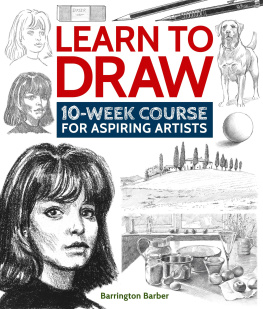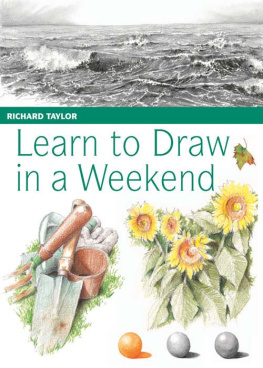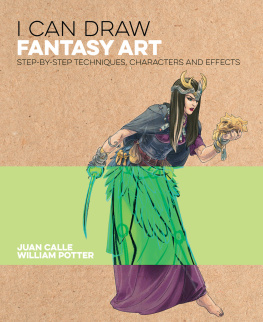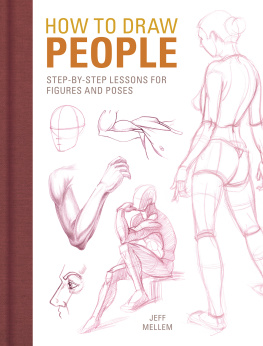How to Draw
A Comprehensive
Drawing Course:
Still Life, Landscapes,
Buildings, People,
and Portraits
IAN SIDAWAY AND SUSIE HODGE

How to Draw
CompanionHouse Books is an imprint of Fox Chapel Publishers International Ltd.
Project Team
Vice PresidentContent: Christopher Reggio
Editor: Katie Ocasio
Copy Editor: Laura Taylor
Design: Mary Ann Kahn
Index: Elizabeth Walker
Copyright 2019 by IMM Lifestyle Books
All rights reserved. No part of this book may be reproduced, stored in a retrieval system, or transmitted in any form or by any means, electronic, mechanical, photocopying, recording, or otherwise, without the prior written permission of Fox Chapel Publishers, except for the inclusion of brief quotations in an acknowledged review.
ISBN 978-1-62008-295-9
The Cataloging-in-Publication Data is on file with the Library of Congress.
This book has been published with the intent to provide accurate and authoritative information in regard to the subject matter within. While every precaution has been taken in the preparation of this book, the author and publisher expressly disclaim any responsibility for any errors, omissions, or adverse effects arising from the use or application of the information contained herein.

Fox Chapel Publishing | Fox Chapel Publishers International Ltd. |
903 Square Street | 7 Danefield Road, Selsey (Chichester) |
Mount Joy, PA 17552 | West Sussex PO20 9DA, U.K. |
www.facebook.com/companionhousebooks
We are always looking for talented authors. To submit an idea, please send a brief inquiry to .
Printed and bound in China
22 21 20 192 4 6 8 10 9 7 5 3 1



CONTENTS

Introduction
Give anyone a pencil and a piece of paper and they will begin to draw. Its as if a forgotten mental mechanism clicks in and the process begins without any coaxing. Admittedly the results may be crude, but the desire to make marks on a surface is almost compulsive. As children we draw before we can write. The act is instinctive; all children do it. What a shame that as the act of writing takes precedence, drawing, due to lack of practice, becomes a forgotten skill.
Drawing is of immense importance to the visual artist; it underpins everything the artist does. The artists vocabulary consists of abstract marks and techniques that are combined visually to make a coherent image. Learning how to do this requires two distinct disciplines. The first is learning how to really look at things and the second is learning how to thoroughly exploit the tools and materials being used.

We look at things all the time. But do we really see them? The artist is trained to consider and take specific note of those things that an untrained eye might not consider important. These include not only shape and size, but also the quality of the light, shade and tone, color and texture, perspective, and composition.
The second discipline involves learning the techniques and the full potential of the materials. A successful drawing combines technical skill and vision. Technical skill is the easier of the two to learn. It comes with practice and experimentation. The more confidence you have in handling your materials, the more accomplished your drawings will become. The aim is to become so familiar with your materials that you develop an instinctive feel when handling them. This frees the mind for concentrating on looking and helps give the drawing that look of accomplished spontaneity.

Using the Book
The ten projects within each section cover a variety of materials, techniques, and subjects. The projects become marginally more complex and involved as you progress through each section. The lessons are cumulative and what is learned on one can be carried forward to the next, so the absolute beginner may find it better to progress through each section in order.
In addition to the main drawing, each project includes an alternative drawing of the same or a similar subject made using a different drawing material and is included for you to attempt your own treatment and variation without having to find your own subject on location. The treatments for each project are merely suggestions; the variations and possibilities are endless and this book acts only a starting point. Apply what you learn here to make your own drawings, and you will find that your love and enjoyment increases as you learn to analyze what is before you more clearly. By following the tips and suggestions in this book, you will develop both your confidence and your drawing style. Try to get into the habit of drawing a little each day and youll soon become an expert.
Remember that there is no single correct way to draw. All artists have their own way of responding to a subject and the beauty of art is that very thingwhatever you do is right for you. Dont be intimidated by the finish of any of the drawings here, nor be disheartened if you make some mistakes along the way. It is perfectly valid to draw each portrait without including every variation in tone or detail. You can also always stop drawing at any point, leaving your picture lighter and sketchier. But most important of all, relax; enjoy your drawing and the results will follow!

Tools and Materials
The materials needed to begin drawing are simple: a tool with which to make a mark and a sheet of paper on which to make it. Pencils and paper are the starting materials for most people. Keep a pen or pencil and sketchbook handy to jot down visual notes wherever you may be. Remember that no one has to see these sketchestheyre your own private workings to help develop your eye. Also, try out ways of showing tones using different materials.
As you grow as an artist, you will soon find that you want to try out different techniques and new materials. Despite many technological advances, artists materials have changed little over the centuries. Nowadays, most materials are easier to use and there is a wider range of pigments available, but essentially, the way we use them remains virtually unchanged. This section describes the tools and materials used in this book. Use it as a guide when you are purchasing your equipment. Fortunately, most drawing materials are relatively inexpensive and capable of producing many drawings before they need to be replaced. It is recommended that to avoid unnecessary expense and disappointment, buy moderately at first. Begin with a medium that appeals to you and phase in others gradually as you feel the need to broaden your range and refresh your approach.















